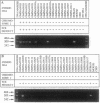Abstract
We have developed a low stringency polymerase chain reaction (LSPCR) to isolate the unknown neighboring region around a known DNA sequence, thus allowing efficient targeted gene walking. The method involves the polymerase chain reaction (PCR) with a single primer under conditions of low stringency for primer annealing (40 degrees C) for the first few cycles followed by more cycles at high stringency (55 degrees C). This enables the amplification of a targeted DNA fragment along with other nontargeted fragments. High stringency (55 degrees C) nested PCRs with end-labeled primers are then used to generate a ladder of radioactive bands, which accurately identifies the targeted fragment(s). We performed LSPCR on human placental DNA using a highly conserved sodium channel-specific primer for 5 cycles at 40 degrees C followed by 27 cycles at 55 degrees C for primer annealing. Subsequently, using higher stringency (55 degrees C) PCR with radiolabeled nested primers for 8 cycles, we have isolated a 0.66-kb fragment of a putative human sodium channel gene. Partial sequence (325 bp) of this fragment revealed a 270-bp region (exon) with homology to the rat brain sodium channel III alpha (RBIII) gene at the nucleotide (87%) and amino acid (92%) levels. Therefore, we putatively assign this sequence as a part of a gene coding the alpha-subunit of a human brain type III sodium channel (SCN3A). Using PCR on two human/rodent somatic cell hybrid panels with primers specific to this putative SCN3A gene, we have localized this gene to chromosome 2. Fluorescence in situ hybridization to human metaphase chromosomes was used to sublocalize the SCN3A gene to chromosome at 2q24-31. In conclusion, LSPCR is an efficient and sensitive method for targeted gene walking and is also useful for the isolation of homologous genes in related species.
Full text
PDF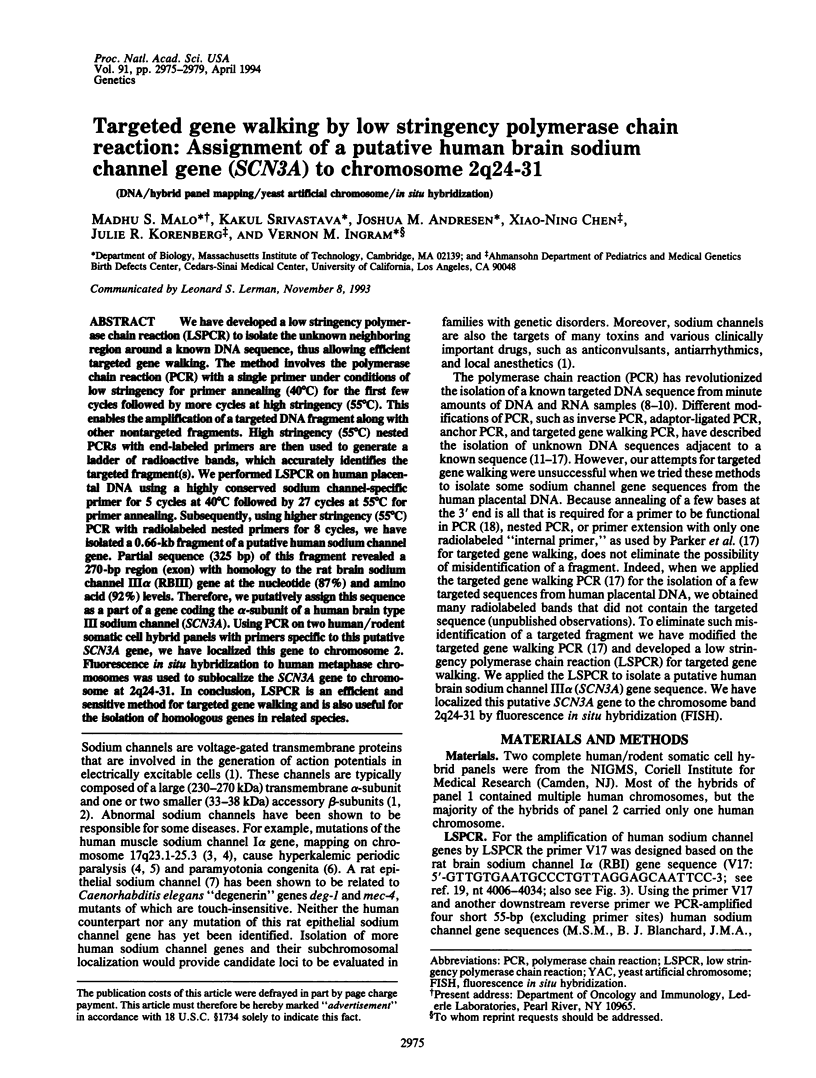
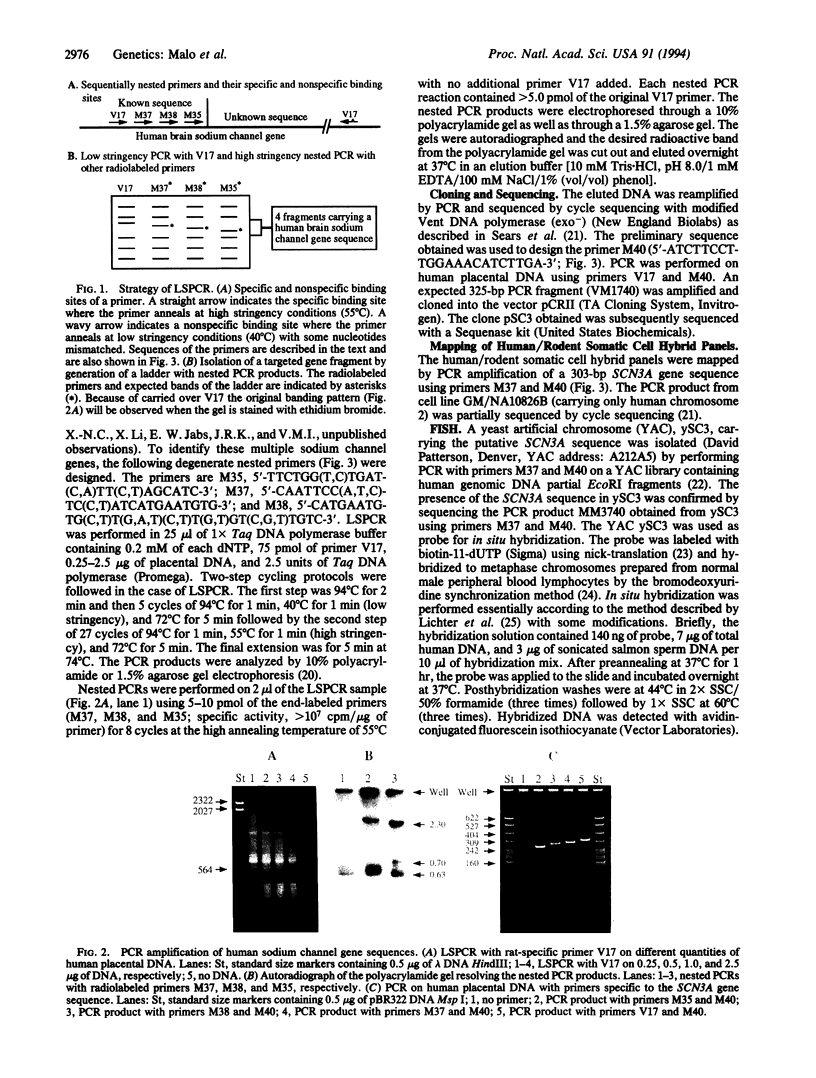
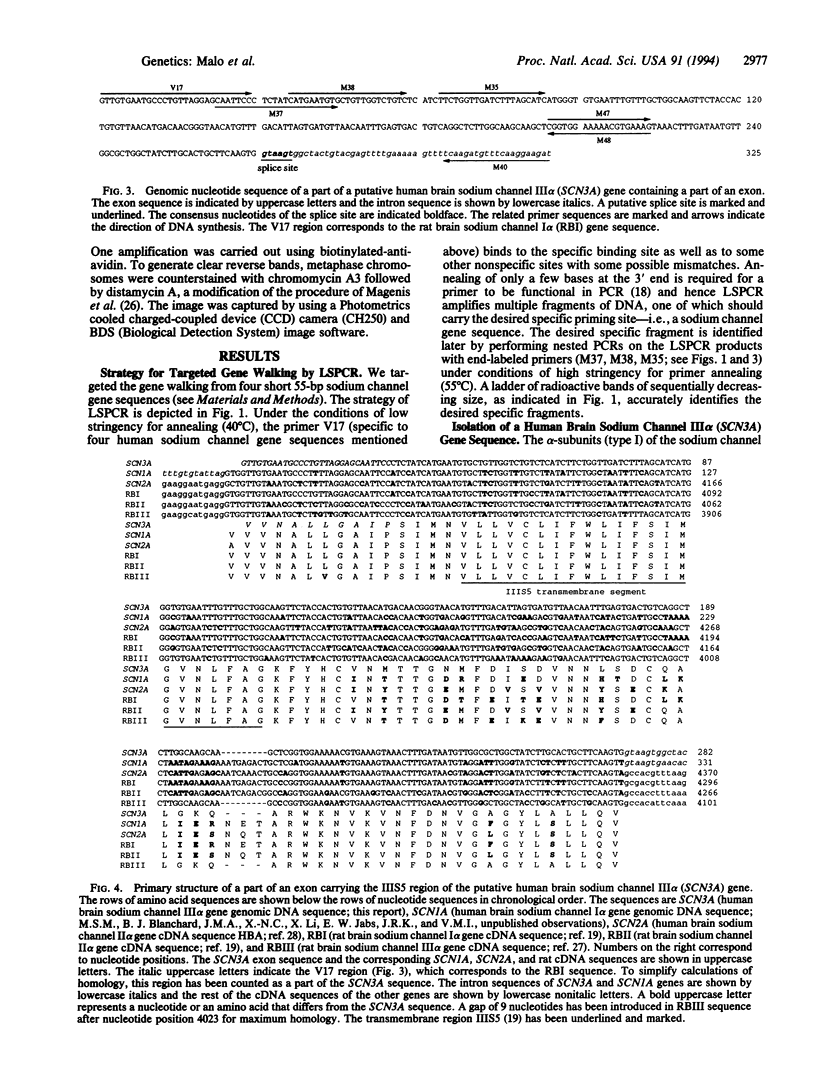

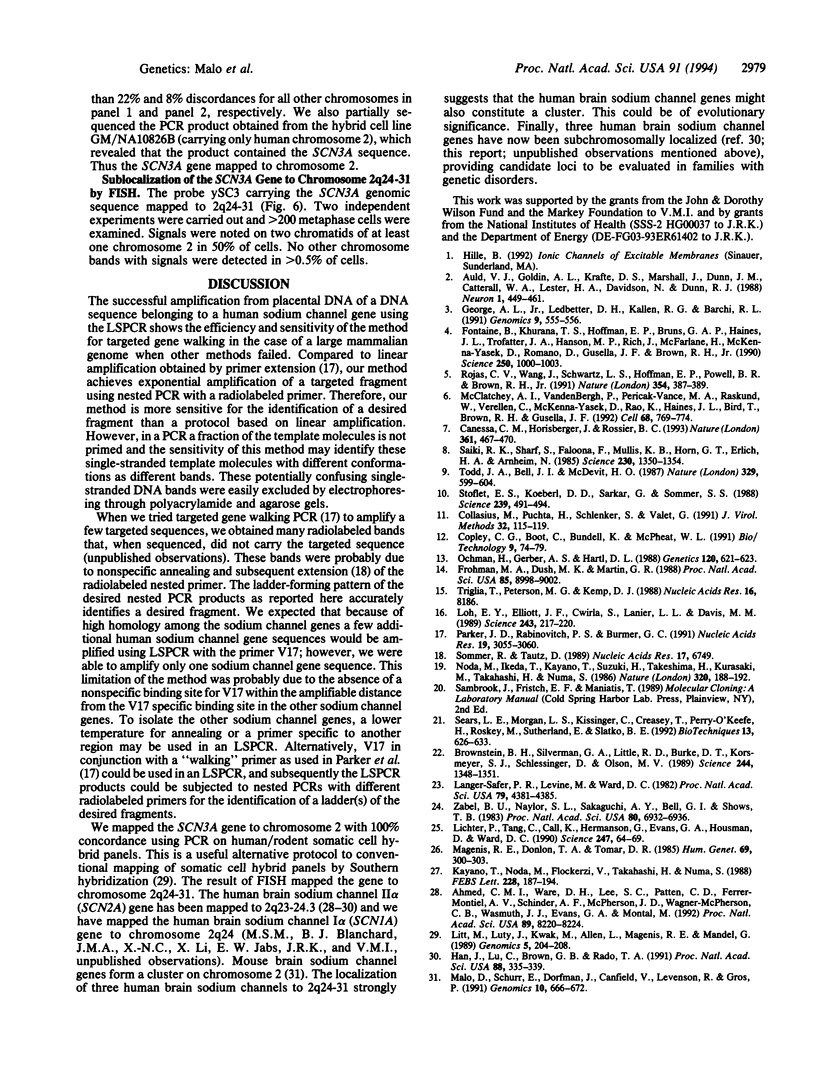
Images in this article
Selected References
These references are in PubMed. This may not be the complete list of references from this article.
- Ahmed C. M., Ware D. H., Lee S. C., Patten C. D., Ferrer-Montiel A. V., Schinder A. F., McPherson J. D., Wagner-McPherson C. B., Wasmuth J. J., Evans G. A. Primary structure, chromosomal localization, and functional expression of a voltage-gated sodium channel from human brain. Proc Natl Acad Sci U S A. 1992 Sep 1;89(17):8220–8224. doi: 10.1073/pnas.89.17.8220. [DOI] [PMC free article] [PubMed] [Google Scholar]
- Auld V. J., Goldin A. L., Krafte D. S., Marshall J., Dunn J. M., Catterall W. A., Lester H. A., Davidson N., Dunn R. J. A rat brain Na+ channel alpha subunit with novel gating properties. Neuron. 1988 Aug;1(6):449–461. doi: 10.1016/0896-6273(88)90176-6. [DOI] [PubMed] [Google Scholar]
- Brownstein B. H., Silverman G. A., Little R. D., Burke D. T., Korsmeyer S. J., Schlessinger D., Olson M. V. Isolation of single-copy human genes from a library of yeast artificial chromosome clones. Science. 1989 Jun 16;244(4910):1348–1351. doi: 10.1126/science.2544027. [DOI] [PubMed] [Google Scholar]
- Canessa C. M., Horisberger J. D., Rossier B. C. Epithelial sodium channel related to proteins involved in neurodegeneration. Nature. 1993 Feb 4;361(6411):467–470. doi: 10.1038/361467a0. [DOI] [PubMed] [Google Scholar]
- Collasius M., Puchta H., Schlenker S., Valet G. Analysis of unknown DNA sequences by polymerase chain reaction (PCR) using a single specific primer and a standardized adaptor. J Virol Methods. 1991 Apr;32(1):115–119. doi: 10.1016/0166-0934(91)90191-2. [DOI] [PubMed] [Google Scholar]
- Copley C. G., Boot C., Bundell K., McPheat W. L. Unknown sequence amplification: application to in vitro genome walking in Chlamydia trachomatis L2. Biotechnology (N Y) 1991 Jan;9(1):74–79. doi: 10.1038/nbt0191-74. [DOI] [PubMed] [Google Scholar]
- Fontaine B., Khurana T. S., Hoffman E. P., Bruns G. A., Haines J. L., Trofatter J. A., Hanson M. P., Rich J., McFarlane H., Yasek D. M. Hyperkalemic periodic paralysis and the adult muscle sodium channel alpha-subunit gene. Science. 1990 Nov 16;250(4983):1000–1002. doi: 10.1126/science.2173143. [DOI] [PubMed] [Google Scholar]
- Frohman M. A., Dush M. K., Martin G. R. Rapid production of full-length cDNAs from rare transcripts: amplification using a single gene-specific oligonucleotide primer. Proc Natl Acad Sci U S A. 1988 Dec;85(23):8998–9002. doi: 10.1073/pnas.85.23.8998. [DOI] [PMC free article] [PubMed] [Google Scholar]
- George A. L., Jr, Ledbetter D. H., Kallen R. G., Barchi R. L. Assignment of a human skeletal muscle sodium channel alpha-subunit gene (SCN4A) to 17q23.1-25.3. Genomics. 1991 Mar;9(3):555–556. doi: 10.1016/0888-7543(91)90425-e. [DOI] [PubMed] [Google Scholar]
- Han J. A., Lu C. M., Brown G. B., Rado T. A. Direct amplification of a single dissected chromosomal segment by polymerase chain reaction: a human brain sodium channel gene is on chromosome 2q22-q23. Proc Natl Acad Sci U S A. 1991 Jan 15;88(2):335–339. doi: 10.1073/pnas.88.2.335. [DOI] [PMC free article] [PubMed] [Google Scholar]
- Kayano T., Noda M., Flockerzi V., Takahashi H., Numa S. Primary structure of rat brain sodium channel III deduced from the cDNA sequence. FEBS Lett. 1988 Feb 8;228(1):187–194. doi: 10.1016/0014-5793(88)80614-8. [DOI] [PubMed] [Google Scholar]
- Langer-Safer P. R., Levine M., Ward D. C. Immunological method for mapping genes on Drosophila polytene chromosomes. Proc Natl Acad Sci U S A. 1982 Jul;79(14):4381–4385. doi: 10.1073/pnas.79.14.4381. [DOI] [PMC free article] [PubMed] [Google Scholar]
- Lichter P., Tang C. J., Call K., Hermanson G., Evans G. A., Housman D., Ward D. C. High-resolution mapping of human chromosome 11 by in situ hybridization with cosmid clones. Science. 1990 Jan 5;247(4938):64–69. doi: 10.1126/science.2294592. [DOI] [PubMed] [Google Scholar]
- Litt M., Luty J., Kwak M., Allen L., Magenis R. E., Mandel G. Localization of a human brain sodium channel gene (SCN2A) to chromosome 2. Genomics. 1989 Aug;5(2):204–208. doi: 10.1016/0888-7543(89)90047-5. [DOI] [PubMed] [Google Scholar]
- Loh E. Y., Elliott J. F., Cwirla S., Lanier L. L., Davis M. M. Polymerase chain reaction with single-sided specificity: analysis of T cell receptor delta chain. Science. 1989 Jan 13;243(4888):217–220. doi: 10.1126/science.2463672. [DOI] [PubMed] [Google Scholar]
- Magenis R. E., Donlon T. A., Tomar D. R. Localization of the beta-globin gene to 11p15 by in situ hybridization: utilization of chromosome 11 rearrangements. Hum Genet. 1985;69(4):300–303. doi: 10.1007/BF00291645. [DOI] [PubMed] [Google Scholar]
- Malo D., Schurr E., Dorfman J., Canfield V., Levenson R., Gros P. Three brain sodium channel alpha-subunit genes are clustered on the proximal segment of mouse chromosome 2. Genomics. 1991 Jul;10(3):666–672. doi: 10.1016/0888-7543(91)90450-s. [DOI] [PubMed] [Google Scholar]
- McClatchey A. I., Van den Bergh P., Pericak-Vance M. A., Raskind W., Verellen C., McKenna-Yasek D., Rao K., Haines J. L., Bird T., Brown R. H., Jr Temperature-sensitive mutations in the III-IV cytoplasmic loop region of the skeletal muscle sodium channel gene in paramyotonia congenita. Cell. 1992 Feb 21;68(4):769–774. doi: 10.1016/0092-8674(92)90151-2. [DOI] [PubMed] [Google Scholar]
- Noda M., Ikeda T., Kayano T., Suzuki H., Takeshima H., Kurasaki M., Takahashi H., Numa S. Existence of distinct sodium channel messenger RNAs in rat brain. Nature. 1986 Mar 13;320(6058):188–192. doi: 10.1038/320188a0. [DOI] [PubMed] [Google Scholar]
- Ochman H., Gerber A. S., Hartl D. L. Genetic applications of an inverse polymerase chain reaction. Genetics. 1988 Nov;120(3):621–623. doi: 10.1093/genetics/120.3.621. [DOI] [PMC free article] [PubMed] [Google Scholar]
- Parker J. D., Rabinovitch P. S., Burmer G. C. Targeted gene walking polymerase chain reaction. Nucleic Acids Res. 1991 Jun 11;19(11):3055–3060. doi: 10.1093/nar/19.11.3055. [DOI] [PMC free article] [PubMed] [Google Scholar]
- Rojas C. V., Wang J. Z., Schwartz L. S., Hoffman E. P., Powell B. R., Brown R. H., Jr A Met-to-Val mutation in the skeletal muscle Na+ channel alpha-subunit in hyperkalaemic periodic paralysis. Nature. 1991 Dec 5;354(6352):387–389. doi: 10.1038/354387a0. [DOI] [PubMed] [Google Scholar]
- Saiki R. K., Scharf S., Faloona F., Mullis K. B., Horn G. T., Erlich H. A., Arnheim N. Enzymatic amplification of beta-globin genomic sequences and restriction site analysis for diagnosis of sickle cell anemia. Science. 1985 Dec 20;230(4732):1350–1354. doi: 10.1126/science.2999980. [DOI] [PubMed] [Google Scholar]
- Sears L. E., Moran L. S., Kissinger C., Creasey T., Perry-O'Keefe H., Roskey M., Sutherland E., Slatko B. E. CircumVent thermal cycle sequencing and alternative manual and automated DNA sequencing protocols using the highly thermostable VentR (exo-) DNA polymerase. Biotechniques. 1992 Oct;13(4):626–633. [PubMed] [Google Scholar]
- Sommer R., Tautz D. Minimal homology requirements for PCR primers. Nucleic Acids Res. 1989 Aug 25;17(16):6749–6749. doi: 10.1093/nar/17.16.6749. [DOI] [PMC free article] [PubMed] [Google Scholar]
- Stoflet E. S., Koeberl D. D., Sarkar G., Sommer S. S. Genomic amplification with transcript sequencing. Science. 1988 Jan 29;239(4839):491–494. doi: 10.1126/science.3340835. [DOI] [PubMed] [Google Scholar]
- Todd J. A., Bell J. I., McDevitt H. O. HLA-DQ beta gene contributes to susceptibility and resistance to insulin-dependent diabetes mellitus. Nature. 1987 Oct 15;329(6140):599–604. doi: 10.1038/329599a0. [DOI] [PubMed] [Google Scholar]
- Triglia T., Peterson M. G., Kemp D. J. A procedure for in vitro amplification of DNA segments that lie outside the boundaries of known sequences. Nucleic Acids Res. 1988 Aug 25;16(16):8186–8186. doi: 10.1093/nar/16.16.8186. [DOI] [PMC free article] [PubMed] [Google Scholar]
- Zabel B. U., Naylor S. L., Sakaguchi A. Y., Bell G. I., Shows T. B. High-resolution chromosomal localization of human genes for amylase, proopiomelanocortin, somatostatin, and a DNA fragment (D3S1) by in situ hybridization. Proc Natl Acad Sci U S A. 1983 Nov;80(22):6932–6936. doi: 10.1073/pnas.80.22.6932. [DOI] [PMC free article] [PubMed] [Google Scholar]





